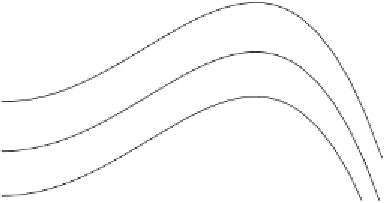Environmental Engineering Reference
In-Depth Information
γ
1
s
gn
2
k
1
1.5
0.5
s
gn
1
1
s
gn
0.1
2
Figure 5.19. Dispersion relation for prototype model (
5.34
), with spatial coupling a
la Swift-Hohenberg for three values of noise intensity (
a
=−
1,
D
=
2, and
k
0
=
1).
stable state
s
c
.
Mathematically, we can understand the short-term instability by observing that when
φ
φ
0
tend to disappear in spite of their initial amplification when
s
gn
>
is close to zero the disturbance effect that is due to the (multiplicative) noise tends
to prevail on the restoring effect of
f
. Conversely, as
3
of
φ
grows, the leading term
φ
0
.
Once the presence of a short-term instability has been detected, the capability of
spatiotemporal stochastic model (
5.34
) to generate patterns can be investigated, for
example, by use of the stability analysis by normal modes (see Box 5.1). In the case
of prototype model (
5.34
) we obtain from Eq. (
B5.1-4
) a dispersion relation
f
(
φ
) prevails over
g
and the deterministic local kinetics
f
tends to restore the state
φ
D
(
k
0
−
k
2
)
2
γ
(
k
)
=
a
+
s
gn
−
,
(5.39)
which provides the same threshold
s
c
as Eq. (
5.36
) for neutral stability; the maximum
amplification is for the wave number
k
=
k
0
(see Fig.
5.19
). It follows that statistically
steady periodic patterns, with wavelength
λ
=
2
π/
k
0
, emerge when the noise intensity
exceeds the threshold
s
c
=−
a
.
The analysis of the structure function can be used as a prognostic tool to confirm
these results. The linear evolution of the structure function from Eq. (
B5.2-6
)is
∂
2
a
k
2
)
2
S
(
k
S
(
k
,
t
)
D
(
k
0
−
=
+
s
gn
−
,
t
)
.
(5.40)
∂
t
Thus neutral stability corresponds to a critical value of the noise intensity:
D
(
k
0
−
k
2
)
2
s
c
=−
a
+
.
(5.41)
When
s
gn
<
s
c
, the structure function tends to zero and no patterns occur. Conversely,
when threshold (
5.41
) is exceeded, the linear evolution of the structure function is
divergent and a range of wave numbers becomes unstable. Notice that the wave
number most prone to instability is
k
a
. Therefore
these results are consistent with those obtained from the stability analysis.
=
k
0
, which corresponds to
s
c
=−














Search WWH ::

Custom Search